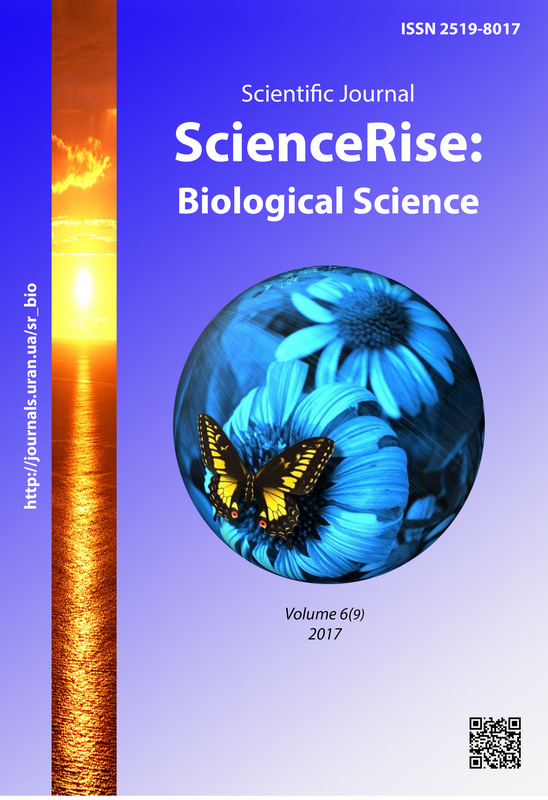Potentiometric determination of antioxidant activity of extracts of Calendula Officinalis L. plants under the influence of growth biostimulants
DOI:
https://doi.org/10.15587/2519-8025.2017.119086Keywords:
Сalendula officinalis L., biostimulants of growth, potentiometric method, antioxidant activity, oxidation-reducing potentialAbstract
There was determined the integral antioxidant activity of water and alcohol extracts of racemes of Calendula officinalis L. plants of the variety “Poliova krasunya”. Plants were cultivated in Precarpathian zone of Ukraine at the learning-research plot of Drogobych state pedagogical university, named after Ivan Franko at introduction of growth biostimulants “Vermibiomag”, “Vermiiodis” and “Vermistim”. The determination of antioxidant activity was realized by the potentiometric method, modified in the authors’ research using mediator system, based on the method of Brainina and co-authors and Aronbaev and co-authors. It was elucidated, that alcohol extracts of C. officinalis plants demonstrate antioxidant activity 1,5 – 1,6 times higher than water ones. Plants, cultivated under the effect of biostimulants have the higher antioxidant activity comparing with the control (without introducing biostimulants). Introduction of “Verbiomag” biostimulator to a greatest extent favored the growth of antioxidant activity of both alcohol (by 22,9 % more than the control) and water extracts (by 24,2 % higher than the control)
References
- Safonov, M. M. (2010). Povnyi atlas likarskykh roslyn [A complete atlas of medicinal plants]. Ternopil: Educational book – Bohdan, 381.
- Hoiko, I. Yu. (2013). Vyznachennia okysliuvalno-vidnovliuvalnoho potentsialu dlia kharakterystyky antyoksydantnoi aktyvnosti netradytsiinoi roslynnoi syrovyny [Determination of the oxidation-reducing potential for the characterization of antioxidant activity of non-traditional plant material]. Food Industry, 14, 6–9.
- Holovko, M. P., Penkina, N. M., Kolesnyk, V. V. (2011). Antyoksydantni vlastyvosti deiakykh vydiv roslynnoi syrovyny [Antioxidant properties of some kinds of vegetable raw material]. Eastern-European Journal of Enterprise Technologies, 4 (6 (52)), 9–11. Available at: http://journals.uran.ua/eejet/article/view/1414
- Lupak, O. M., Klepach, H. M., Antonyak, H. L. (2017). Vplyv biostymuliatoriv na aktyvnist enzymiv antyoksydantnoi systemy u roslynakh Calendula officinalis L. v umovakh Zakhidnoho Lisostepu Ukrainy [Influence of biostimulants on activity of enzymes of antioxidant system in plants of Calendula officinalis L. in conditions of Western forest-steppe of Ukraine]. Studia Biologica, 11 (3-4), 28–29.
- Terek, O. I., Patsula, O. I. (2011). Rist i rozvytok roslyn: navch. posibnyk [Plant growth and development: educ. appliance]. Lviv: LNU imeni Ivana Franka, 328.
- Horchakova, N. O., Oliinyk, S. A., Harkava, K. H., Kuprash, L. P., Chekman, I. S., Tumanov, V. A. et. al. (2000). Antyoksydantni zasoby – neobkhidni komponenty kompleksnoi farmakoterapii [Antioxidants – the necessary components of complex pharmacotherapy]. Phytotherapy in Ukraine, 1 (9), 7–13.
- Chekman, I. S. (2000). Flavonoidy – kliniko-farmakolohichnyi aspekt [Flavonoids – clinical and pharmacological aspect]. Phytotherapy in Ukraine, 2, 3–5.
- Hryshko, V. M., Demura, T. A. (2009). Vplyv rehuliatoriv rostu na stiikist prorostkiv kukurudzy, rozvytok protsesiv perokysnoho okysnennia lipidiv i vmist askorbinovoi kysloty za sumisnoi dii kadmiiu i nikeliu [Influence of growth regulators on the stability of corn seedlings, the development of processes of lipid peroxidation and the content of ascorbic acid by the combined action of cadmium and nickel]. Physiology and biochemistry of cultivated plants, 41 (4), 335–343.
- Kolupaiev, Yu. Ye., Oboznyi, O. I. (2013). Aktyvni formy kysniu i antyoksydantna systema pry perekhresnii adaptatsii roslyn do dii abiotychnykh stresoriv [Active forms of oxygen and antioxidant system at cross-adaptation of plants to action of abiotic stressors]. Bulletin of Kharkiv National Agrarian University. Series: Biology, 3 (30), 18–31.
- Yevlash, V. V., Mikhailenko, V. H., Akmen, V. O. (2011). Adaptatsiia metodu kulonometrychnoho tytruvannia shchodo vyznachennia antyoksydantnoi aktyvnosti roslynnoi syrovyny ta diietychnykh dobavok [Adaptation of the method of coulometric titration to determine the antioxidant activity of plant material and dietary supplements]. Eastern-European Journal of Enterprise Technologies, 5 (3 (53)), 56–59. Available at: http://journals.uran.ua/eejet/article/view/1196
- Aronbaev, D. M., Ten, V. A., Yulaev, M. F., Aronbaev, S. D. (2015). Issledovanie antioksidantnoy aktivnosti rastitelnosti Ferganskoy dolinyi [Study of the antioxidant activity of the vegetation of the Fergana Valley]. Young scientist, 4 (84), 30–34.
- Ivanova, A. V., Gerasimova, E. L., Brainina, K. Z. (2015). Potentiometric Study of Antioxidant Activity: Development and Prospects. Critical Reviews in Analytical Chemistry, 45 (4), 311–322. doi: 10.1080/10408347.2014.910443
- Dospehov, B. A. (1985). Metodika polevogo opyita [Technique of field experience]. Moscow: Agropromizdat, 351.
- Gosudarstvennaya farmakopeya SSSR: Issue 2. Obschie metodyi analiza. Lekarstvennoe rastitelnoe syire [State Pharmacopoeia of the USSR: Issue 2. General methods of analysis. Medicinal plant raw materials] (1989). Moscow: Medicine, 400.
- Derzhavna Farmakopeia Ukrainy. Vol. 3 [State Pharmacopoeia of Ukraine. Vol. 3] (2014). Kharkiv: State Enterprise “Ukrainian Scientific Pharmacopoeial Center for Quality of Medicines”, 732.
Downloads
Published
How to Cite
Issue
Section
License
Copyright (c) 2017 Oksana Lupak, Halyna Kovalchuk, Halyna Antonyak

This work is licensed under a Creative Commons Attribution 4.0 International License.
Our journal abides by the Creative Commons CC BY copyright rights and permissions for open access journals.
Authors, who are published in this journal, agree to the following conditions:
1. The authors reserve the right to authorship of the work and pass the first publication right of this work to the journal under the terms of a Creative Commons CC BY, which allows others to freely distribute the published research with the obligatory reference to the authors of the original work and the first publication of the work in this journal.
2. The authors have the right to conclude separate supplement agreements that relate to non-exclusive work distribution in the form in which it has been published by the journal (for example, to upload the work to the online storage of the journal or publish it as part of a monograph), provided that the reference to the first publication of the work in this journal is included.









